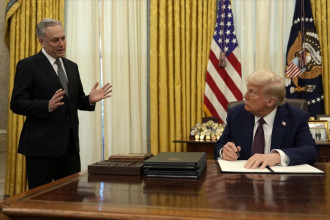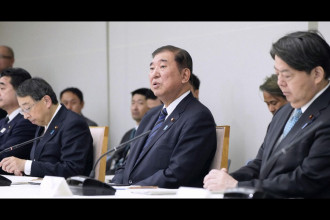-1735453962.jpg)
SEOUL: A jetliner skidded off the runway, collided with a concrete barrier, and erupted into flames on Sunday in South Korea after its landing gear seemingly failed to deploy. The incident claimed the lives of 179 out of the 181 people on board, making it one of the nation’s most catastrophic aviation disasters, officials confirmed.
The Boeing 737-800, operated by Jeju Air, had arrived from Bangkok and met its tragic end while attempting to land in the town of Muan, approximately 290 kilometres south of Seoul.
Footage broadcast by South Korean television depicted the aircraft hurtling down the runway at high speed, apparently with its landing gear still retracted, before slamming into the barrier and igniting an explosion that sent thick plumes of black smoke billowing into the air.
The South Korean fire agency reported that 179 people perished in the crash. Emergency responders rescued two crew members who were conscious and not suffering from life-threatening injuries, according to health officials.
Lee Jeong-hyeon, the chief of the Muan fire station, stated in a televised briefing that the plane was obliterated, with only the tail assembly remaining recognisable amidst the wreckage. Investigations are underway to determine the cause of the crash, including the possibility of bird strikes, Lee noted.
Transport Ministry officials stated that the control tower had issued a bird warning to the aircraft shortly before its intended landing and had granted permission to land in an alternate area. The crew transmitted a distress signal just prior to the crash.
Senior Transport Ministry official Joo Jong-wan announced that investigators had retrieved the jet’s flight data and cockpit voice recorders, indicating that the full investigation could take several months. The runway will remain closed until 1 January, the ministry added.
John Cox, a retired airline pilot and CEO of Safety Operating Systems in St Petersburg, Florida, commented that video footage suggested the pilots did not deploy flaps or slats to decelerate the aircraft, indicating a potential hydraulic failure, and did not manually lower the landing gear, possibly due to a lack of time. Cox noted that the aircraft was under control and travelling in a straight line; the severity of the disaster was likely exacerbated by the proximity of the barrier to the runway.
“It’s all in one piece. Everything is coming along fine until it hits that wall, at which point it disintegrates into a catastrophe,” Cox said.
Ross “Rusty” Aimer, CEO of Aero Consulting Experts, added that videos showed the aircraft consuming much of the runway before touchdown. With limited braking capability, the aircraft skidded on its engine cowlings. “It’s basically like skidding on ice,” he said.
Alan Price, a former chief pilot at Delta Air Lines and now a consultant, stated that the Boeing 737-800 is a “proven aeroplane” and belongs to a different class than the Boeing 737 Max, which was involved in fatal crashes in 2018 and 2019. According to aviation analytics firm Cirium, over 4,500 of these aircraft are in operation globally.
Ju Woong, director of the Ewha Womans University Seoul Hospital, reported that one of the survivors was being treated for fractures to his ribs, shoulder blade, and upper spine. Ju mentioned that the man, whose identity remains undisclosed, recalled waking up to find himself rescued. Details regarding the other survivor were not immediately available.
The majority of the passengers were South Korean nationals, with two individuals from Thailand among them. Officials identified 88 passengers in the hours following the crash, according to the fire agency.
Thai Prime Minister Paetongtarn Shinawatra expressed condolences to the families of the victims in a post on X, instructing the Ministry of Foreign Affairs to provide assistance.
Boonchuay Duangmanee, the father of a Thai passenger, told The Associated Press that his daughter, Jongluk, had been working in a South Korean factory for several years and had recently returned to Thailand to visit her family. “I never thought that this would be the last time we would see each other forever,” he said.
Kerati Kijmanawat, director of Thailand’s airports, confirmed in a statement that Jeju Air flight 7C 2216 had departed from Bangkok’s Suvarnabhumi Airport without any reported abnormalities.
Jeju Air issued a statement expressing its “deep apology” for the crash and pledged to manage the aftermath of the accident diligently.
In a televised news conference, Jeju Air’s president, Kim E-bae, along with senior company officials, offered a profound bow of apology to the bereaved families, taking full responsibility for the crash. Kim stated that no mechanical issues had been identified with the aircraft during regular inspections and awaited the results of government investigations.
Family members mourned as officials announced the names of some victims at a lounge in Muan airport.
Boeing released a statement on X, indicating its contact with Jeju Air and its readiness to support the company.
The crash occurred amidst a political turmoil in South Korea, spurred by President Yoon Suk Yeol’s imposition of martial law and subsequent impeachment. Acting President Han Duck-soo was impeached on Friday, resulting in Deputy Prime Minister Choi Sang-mok assuming presidential duties.
Choi visited the crash site in Muan and urged officials to employ all available resources to promptly identify the deceased. The government declared Muan a special disaster zone and announced a week-long national mourning period.
Yoon’s office reported that Chief Secretary Chung Jin-suk presided over an emergency meeting with senior presidential staff to discuss the crash and briefed Choi. Yoon conveyed his condolences to the victims via Facebook.
In St Peter’s Square in Rome, Pope Francis expressed his prayers for the survivors and the deceased. US President Joe Biden stated that the United States was prepared to offer any necessary assistance.
The Muan crash ranks among the deadliest aviation disasters in South Korea’s history. The most recent large-scale air disaster occurred in 1997 when a Korean Airlines plane crashed in Guam, resulting in 228 fatalities. In 2013, an Asiana Airlines plane crash-landed in San Francisco, killing three and injuring about 200 people.
Sunday’s accident is also one of the worst landing disasters since a July 2007 incident in which an Airbus A320 skidded off a slick runway in Sao Paulo, Brazil, killing all 187 on board and 12 others on the ground, as reported by the Flight Safety Foundation.
In 2010, 158 lives were lost when an Air India Express aircraft overshot a runway in Mangalore, India, and plunged into a gorge before igniting, according to the safety foundation.
By RSS/AP
READ ALSO:






